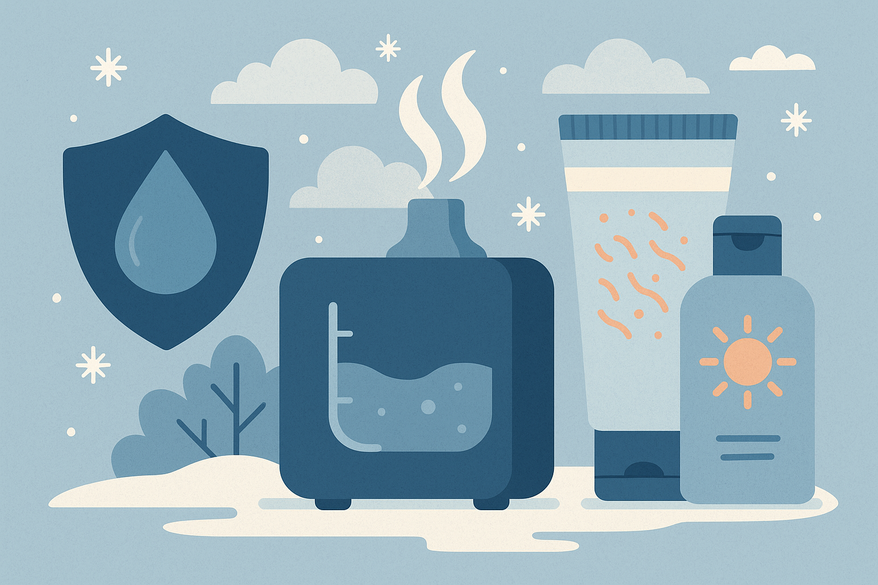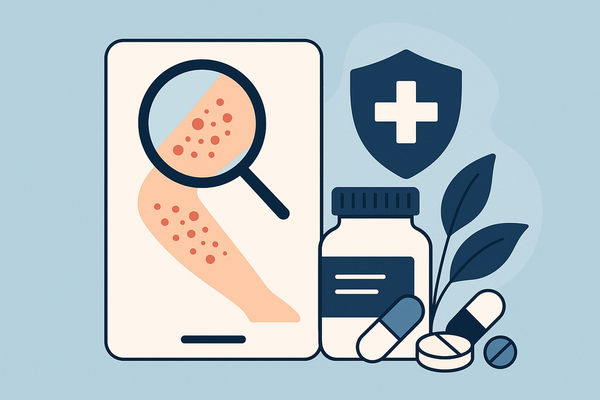Winter Dry Skin Rash Prevention: Your Complete Guide
Learn prevention strategies for winter dry skin rash, including tips on moisture protection, humidity control, and sunscreen for rash-prone skin.

Estimated reading time: 8 minutes
Key Takeaways
- Identify triggers like low humidity, cold wind, indoor heating, UV exposure, chlorine, fungi, and pollen.
- Hydrate and moisturize with emollient-rich, fragrance-free creams immediately after lukewarm showers.
- Control indoor humidity using cool-mist humidifiers and monitor levels at 40–60%.
- Protect skin barrier with breathable layers, wind-resistant clothing, and barrier creams before swimming.
- Use broad-spectrum mineral sunscreen (SPF 30+) on all exposed areas, even in winter.
- Adopt targeted strategies for fungal, chlorine, and pollen-induced rashes.
Table of Contents
- Section I: Understanding Different Types of Rashes
- Section II: Winter Dry Skin Rash Prevention
- Section III: Sunscreen for Rash-Prone Skin
- Section IV: Environmental Triggers – Humidity, Chlorine & Pollen
- Section V: Integrating Prevention Strategies
- Conclusion
- FAQ
Section I: Understanding Different Types of Rashes
I.1 Winter Dryness Rash
Definition: When cold winds, low humidity, and indoor heating strip natural oils, skin becomes red, itchy, and scaly—typically on hands, arms, and face.
I.2 Humidity and Fungal Rashes
Definition: Warm, damp air promotes fungal growth in skin folds, causing ring-shaped, itchy lesions with raised borders.
I.3 Chlorine Rash from Swimming
Definition: Chlorinated water can weaken the skin barrier by stripping lipids, resulting in redness, small bumps, and persistent itching around hair follicles.
I.4 Pollen Allergy Skin Flare-Ups
Definition: Pollen grains adhere to the skin or trigger an immune response, leading to hives, itching, or eczema-like patches on exposed areas.
Section II: Winter Dry Skin Rash Prevention
II.A Causes & Symptoms
- Low humidity: Depletes stratum corneum water content.
- Cold wind: Increases transepidermal water loss.
- Indoor heating: Lowers air moisture.
- Symptoms: Red, inflamed patches; intense itching; scaly, cracked skin; occasional swelling.
II.B Prevention Tips
1. Hydration & Moisturization
- Apply an emollient-rich cream immediately after lukewarm showers.
- Choose products with urea or lactic acid for deeper hydration.
- Avoid fragrances, dyes, and alcohol to minimize irritation.
2. Bathing Adjustments
- Limit showers to 5–10 minutes with lukewarm water.
- Use gentle, soap-free cleansers with glycerin, goat milk, or shea butter.
- Pat skin dry—do not rub—before applying moisturizer.
3. Humidity Control
- Run a cool-mist humidifier to maintain 40–60% indoor humidity.
- Monitor levels with a hygrometer and clean regularly to prevent mold.
4. Protective Clothing
- Wear breathable layers of cotton, hemp, or bamboo next to skin.
- Add wind-resistant outer layers and insulated gloves outdoors.
- Avoid direct wool contact, which can irritate dry skin.
5. Environmental Adjustments
- Keep distance from direct heat sources like fireplaces.
- Use rubber gloves when handling cleaning chemicals or wet dishes.
- Maintain thermostat at 68–72°F for balanced indoor air.
6. Routine Recommendations
- Reapply moisturizer 2–3 times daily or after hand-washing.
- Use natural soothers like aloe vera gel or fractionated coconut oil.
- Keep a small tube of ointment in your bag or car for on-the-go relief.
Section III: Sunscreen for Rash-Prone Skin
III.A Why Winter Sun Protection Matters
Snow reflection increases UV intensity, which can impair the skin barrier and worsen rashes. Broad-spectrum protection is essential year-round.
III.B Winter Sun Protection
- Apply a broad-spectrum mineral sunscreen with SPF 30+ on all exposed areas.
- Put sunscreen on 15 minutes before going outdoors.
- Reapply every two hours or after sweating.
III.C Choosing the Right Formula
- Look for zinc oxide or titanium dioxide bases.
- Avoid chemical filters like oxybenzone or avobenzone.
- Choose fragrance-free, alcohol-free, hypoallergenic formulas.
III.D Hydration & Protection Balance
- First apply a lightweight, fragrance-free moisturizer.
- Layer sunscreen on top to seal hydration.
- Opt for non-comedogenic products to prevent clogged pores.
Section IV: Environmental Triggers – Humidity, Chlorine & Pollen
IV.A Humidity and Fungal Rashes
- Use absorbent antifungal powders on feet, groin, and skin folds.
- Wear moisture-wicking fabrics like polyester blends or bamboo.
- Improve air flow with fans or open windows after bathing.
IV.B Chlorine Rash from Swimming
- Apply a thin layer of petroleum jelly or barrier cream before swimming.
- Rinse off pool water immediately with gentle cleanser.
- Follow up with a rich moisturizer to replenish lost oils.
IV.C Pollen Allergy Skin Flare-Ups
- Change and wash clothes immediately after outdoor exposure.
- Shower and shampoo hair before bedtime to remove pollen residues.
- Run HEPA air filters and keep windows closed during peak pollen counts.
- Use hypoallergenic, fragrance-free skin products.
Section V: Integrating Prevention Strategies
V.1 Seasonal Skincare Playbook
- Winter: Intensive moisturization, barrier creams, cool-mist humidifiers, mineral sunscreen.
- Summer/Humid: Fungal-safe clothing, antifungal powders, light hydrating lotions.
- Swim & Leisure: Barrier protocols before chlorinated pools, immediate post-swim cleansing.
- Allergy Seasons: Pollen hygiene, air purifiers, hypoallergenic skincare.
V.2 Consistent Routines
- Hydrate: water intake plus topical moisturizers daily.
- Protect: broad-spectrum sunscreen even in cold weather.
- Balance: humidity control indoors and ventilation in warm months.
- Guard: barrier measures against chlorine and pollen.
V.3 Professional Guidance
Schedule an annual dermatology check-up for personalized advice and early intervention.
For quick insights, try our AI tool. Here’s a sample report from Rash Detector:

Conclusion
Effective rash prevention hinges on tailored strategies for each trigger: winter dryness, UV exposure, humidity, chlorine, and pollen. Implement these tips—hydrate, protect, balance, and guard—to reduce rash severity and frequency. Monitor your skin’s response and adjust routines as needed. For persistent or severe rashes, consult a board-certified dermatologist.
FAQ
What causes winter dry skin rashes?
Cold winds, low humidity, and indoor heating strip natural oils, leading to red, itchy, scaly patches on exposed skin.
How often should I moisturize in winter?
Reapply moisturizer 2–3 times daily or immediately after hand-washing and showers for optimal hydration.
Can sunscreen help prevent rashes?
Yes. Broad-spectrum mineral sunscreen protects the skin barrier from UV damage that can worsen existing rashes.
How do I prevent fungal rashes in humid conditions?
Wear moisture-wicking fabrics, use antifungal powders on skin folds, and improve ventilation after bathing.
What barrier protection works before swimming?
Apply petroleum jelly or a dimethicone-based barrier cream before entering chlorinated pools, then rinse and moisturize immediately after.





